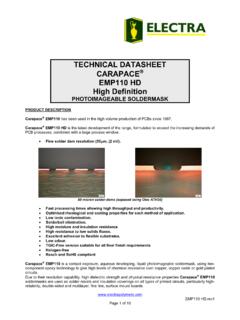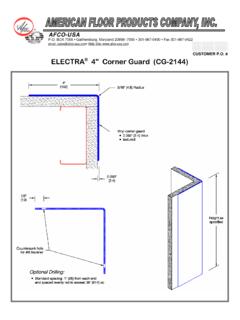Transcription of THE BIOLOGY AND DISTRIBUTION OF HEMILEUCA ELECTRA ...
1 Journal of the Lepidopterists' Society 49(1), 1995, 49-71 THE BIOLOGY AND DISTRIBUTION OF HEMILEUCA ELECTRA ( saturniidae ) populations in THE UNITED STATES AND MEXICO, WITH DESCRIPTIONS OF TWO NEW SUBSPECIES PAUL M. TUSKES 3808 Sioux Avenue, San Diego, California 92117, USA AND STEVEN McELFRESH Department of Entomology, University of California, Riverside, California 92521, USA ABSTRACT. Analysis of adult phenotypes indicates that distinctive populations of HEMILEUCA ELECTRA usually are restricted to well defined desert plant communities. This has resulted in HEMILEUCA ELECTRA clio being separated taxonomically from the Mojave Desert population and the formal recognition of unique populations from the Sonora Desert of Baja California, Mexico.
2 We describe two populations as new subspecies, Hem-ileuca ELECTRA mojavensis and H. ELECTRA rubra, and discuss other populations in southern California and Mexico. The known range of H. ELECTRA has been extended to include southwest Utah, southern Nevada, portions of Arizona, California, and south into Baja California and Baja California Sur, Mexico. Flat-top buckwheat (Eriogonum fascicula-tum) is the only larval hostplant in the United States, but in Mexico other hosts are used. Additional key words: rubra, mojavensis, Lower Colorado Desert, Vizcaino Desert, Mojave Desert. HEMILEUCA ELECTRA Wright is a day-flying saturniid moth that occurs over a vast area, from southwestern Utah to Baja California Sur, Mexico (Fig.)
3 1). The nominate form was described from the California coastal chaparral plant community, but populations occur in the Mojave Desert and in three distinct subdivisions of the Sonoran Desert. Desert com-munities are expansive, often leading the casual observer to believe they are homogenous. However, there is a great deal of complexity in desert plant communities brought on by elevation, edaphic, and climatic factors. When populations are subject to differing natural selection in discontinuous or different habitats, unique phenotypes may develop if gene exchange is sufficiently restricted. Colonization of a new area may be accomplished by a few individuals, or a single female moth resulting in a limited initial gene pool (founder effect).
4 With time, variability of the population may increase, but certain characteristics present in the parent population may be irrevocably lost, or selected against, resulting in unique biological or phenotypic traits. As a result, many distinctive populations may be assigned to one species, and the sum total of these populations and their attributes define the species. As presented in this paper, local populations also may experience unique biotic and abiotic conditions that result in changes in behavior, the time of egg hatch and 50 JOURNAL OF THE LEPIDOPTERISTS' SOCIETY eclosion of adults, and hostplant preferences. Under such circumstances, the taxonomic status of a population may be difficult to assess based only on museum specimens.
5 It has been our observation that among North American HEMILEUCA , the more extensive their range in mosaic environments, the more likely it is for them to express a wide range of variability in all life stages. In reviewing HEMILEUCA ELECTRA populations, we found that some phe-notypes are part of a cline that extends over many km, while another population exhibits such sharp discontinuity that species status was considered. The criteria we used to judge the status of HEMILEUCA species and subspecies is presented in the methods section. The H. ELECTRA populations examined include: (I) nominate H. ELECTRA from coastal chaparral plant community of southern California, south to the area of San Quintin, Baja California, Mexico; (2) HEMILEUCA ELECTRA clio Barnes & McDunnough, a dark phenotype from the Arizona Upland plant community of Arizona; (3) the Mojave Desert population that extends across portions of southern Utah, Nevada, and California, characterized by its distinctly white forewings; (4) a Colorado Desert population extending from Riverside County, California, south into the deserts of Baja California, Mexico, characterized by its smaller size and mottled forewings.
6 (5) a Vizcaino Desert population extending from south of EI Rosario to approximately Rosarito in Baja California, Mexico, characterized by its large size and red coloration; (6) a population in Baja California Sur, Mexico, with a wide range of phenotypes, but with an overall appearance somewhat similar to that found in coastal and desert southern California populations 600 km to the north. Brown (1982) defined and described in detail the above plant communities. METHODS Adult specimens from each population were collected from August to November in traps baited with pheromone-emitting virgin females as described in Collins and Tuskes (1979), or netted as they approached females placed in screen cages.
7 Quantitative characters were measured on field collected males. In order to secure additional females, larvae were collected during February and March and reared to maturity. Specimens also were borrowed from Mike Smith, Pat Savage, David Hawks, Guy Bruyea, and the Natural History Museum of Los Angeles County. Six quantitative characters and eleven qualitative characters were scored on each adult. Quantitative characters included: (I) forewing (FW) length as measured from the apex to wing base; (2) diameter of the FW discal spot; (3) width of white FW medial patch between veins CuI and Cu2; (4) diameter of hind wing (HW) discal spot; (5) width of VOLUME 49, NUMBER 1 ~ Mountains [J H.]
8 ELECTRA ELECTRA Id H. ELECTRA clio I:'j H. ELECTRA mojavensis [[!] H. ELECTRA rubra D H. ELECTRA (Lower Colorado Desert population ) D H. ELECTRA (Baja California Sur population ) 51 Phoenix C) Tucson FIG. 1. DISTRIBUTION of HEMILEUCA ELECTRA populations in the United States and Mexico. black HW margin between veins m2 and m3; and (6) FW length to width ratio (higher values indicate narrower wings). Qualitative char-acters included: (7) black FW submarginal line touching discal spot; (8) presence of red scaling on antemedial area and/or inner FW margin or costal area; (9) color of male HW anal area (red or black); (10) color of ventral abdominal surface (black & white or black & red/pink); (11) color of the thorax (black & white or black (12) color of the thoracic collar (white or red/pink).]
9 (13) transparency of wings [Wings were considered transparent if a data label could be read through the wing, translucent if the data on the label could be seen but not read, 52 JOURNAL OF THE LEPIDOPTERISTS' SOCIETY and opaque if it could not be seen though the wing.]; (14) base of FW black and white or black only; (15) presence or absence of white marking between submarginal line and wing margin; (16) presence or absence of pupil in HW eye spot; and (17) color of the tegula (black & white or black & red). When possible, 20 males and 10 females from each location were scored. The quantitative data were analyzed with a One-Way ANOVA, a correlation matrix and t-test, and discriminant analysis.
10 Discriminant analysis was applied only to males, as too few females were available for a meaningful analysis. Nominate H. ELECTRA was used as the reference population . Data for multiple locations within each population are presented individually in order to better characterize variation. Qual-itative characters were scored and summarized as percent occurrence. Although there is no definition of how distinctive a population must be to warrant subspecies status, we set our criteria as follows. The population must be geographically and phenotypically distinct, and genetically compatible with other populations. Ideally, the characters that define the population would represent an adaptation to a unique environment.









